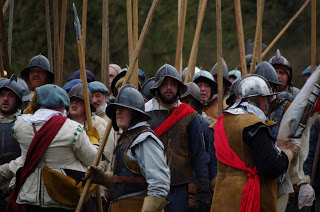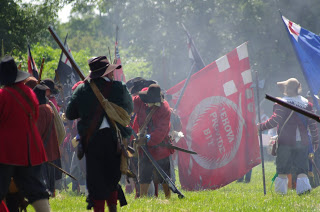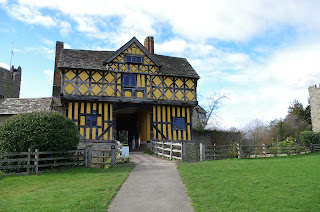General Eoghan Ruadh Ó Néill’s Regiment of Foot
Who? You might be more familiar if I write Eoghan Ruadh Ó Néill as Owen Roe O'Neill. But I won't because he was Irish, not English. Although there is some confusion if he was Eoghan Rua or Eoghan Ruadh. I'll stick with Eoghan Ruadh.
Now please bear with me, as there's rather a lot of Ó Néills running around Ireland in the 1640s.
Eoghan Ruadh had at least eight brothers and four sisters; and was connected through marriage to many of the leading native Irish families of Ulster. His nephews included Daniel Ó Néill and Hugh Dubh Ó Néill both of whom were important figures in 1640s Ireland, as well as Conor, Lord Maguire, one of the original plotters of the 1641 rebellion, and his brother Ruari, who commanded a regiment in the Ulster army during the 1640s.
In Spanish service, 1605–41 Eoghan Ruadh was accompanied by three of his brothers: Phelim, Art Óg, and Cormac. He secured himself a position as captain in the regiment of Henry Ó Néill , son of the Earl of Tyrone. It was whilst serving in Spanish Flanders that Eoghan Ruadh developed a mutual lifelong antagonism between himself and Thomas Preston, the son of Christopher, Viscount Gormanston. Clarendon would describe the spat as ‘perpetual jealousy of each other'.
He would go on to served as governor of Rheinburg on the German frontier during the Spanish–Dutch truce, before returning to military service when the hostilities began again. He served with distinction in a number of military engagements, including the siege of Breda.
From as early as 1640 he had been in contact with his kinsman Sir Phelim Ó Néill. The conspirators, increasingly concerned by the anti-Catholic rhetoric of the Scottish covenanters and Westminster Parliament, hoped to take advantage of Charles I's domestic difficulties to exact concessions in Ireland. Eoghan Ruadh, de facto leader of the Ó Néill interest on the Continent after the death of the Earl of Tyrone near Barcelona, promised to provide military assistance in the event of an uprising.
When news of the Ulster rebellion reached the Continent, he began to make preparations to return home and he managed to slip away from Ostend with a couple of hundred men and officers, landing at Doe Castle in Northern Donegal on the 8th July 1642.
The regiment was raised in Ulster, including many Irish veterans of Tercio Irlandes de Ó Néill returning from Flanders. By August 1642 Eoghan Ruadh took command of the Ulster Army.
They would fight at the battles of Loughgall, Clones, and Portlester in 1643.
Towards the end of 1643 the Catholic Confederation devised a two pronged assault on the Ulster Scots: sending an Irish Brigade, led by Alasdair MacColla MacDonnell, to Scotland in support of Montrose; and to launch a major offensive in Ulster, with forces assembled from all four provinces. Unfortunately Eoghan Ruadh, the seemingly natural commander of this army, was unacceptable to many in the Confederation. The assembly eventually selected James Tuchet, Earl of Castlehaven, as a compromise candidate
So in 1644 the regiment would be present at the standoff at Charlemont under Castlehaven's command. The rest of 1644 and 1645 saw little campaigning, the worst hostilities were a war of words between Eoghan Ruadh and Castlehaven. In October 1645 Eoghan Ruadh travelled to Kilkenny to welcome the papal nuncio, Gian Battista Rinuccini. Rinuccini arrived with money and supplies for the Confederate armies, two-thirds of went to the already well supplied Leinster army of Thomas Preston. Eoghan Ruadh's Ulster army received the remaining third.
The summer of 1646 marked the high point of Confederate military power: Viscount Muskerry, seized the strategic fortress of Bunratty at the mouth of the Shannon; and Preston made significant gains in Connacht, capturing the town of Boyle, County Roscommon. Unfortunately this progress was 'undone' by peace negotiations with the Duke of Ormond, despite opposition from the Catholic clergy due to the absence of religious rights protection.
 |
By now the regiment is believed to have grown to 15 companies in strength, and were equipped with one musket to every pike.
Hostilities would break out again when the clergy took control of the Confederation and metaphorically ripped up the peace treaty. In June the regiment would see itself take up arms again at Ballaghkillgevill; Benburb; and raid from Tanderagee into County Down.
With Rinuccini effectively in control of the Confederate Assembly, Eoghan Ruadh was ordered to march on Dublin
By 1647, the Confederate council was becoming increasingly concerned that the Royalist garrison in Dublin was planning to hand the city over to the Parliamentarians rather than let it fall into the hands of the Irish. Eoghan Ruadh and Preston were ordered to join forces to capture the city before any Parliamentarian forces could arrive. Alas their animosity scuppered any chance of the two armies cooperating and taking the city, and the city was handed over to the Parliamentarians under the command of Michael Jones.
1648, a detachment of the regiment was sent to storm Nenagh, and a detachment of 450 men was sent to relieve Athy.
In January 1649 the Confederate Assembly signed a peace treaty with Ormond, creating a powerful new alliance, excluding Eoghan Ruadh. Rinuccini left for Rome shortly afterwards, while Ormond sent Nicholas Plunkett and Nicholas French to seek a rapprochement with Eoghan Ruadh. Talks broke down and Eoghan Ruadh turned his attention to the Parliamentarians, hoping to reach an agreement that would safeguard the Catholic religion and allow the Ulster Irish to regain their former properties.
Eoghan Ruadh arranged a cease-fire with Colonel George Monck Parliamentarian commander of Dundalk. In July he relieved Charles Coote in the city of Derry, under siege from royalist forces. Shortly afterwards, Michael Jones defeated Ormond at Rathmines, allowing Cromwell to land unchallenged with a large army at Ringsend on 12th August 1649.
By November Eoghan Ruadh was dead; he died on 6th November 1649 at the O'Reilly stronghold of Cloughoughter Castle on an island in Lough Oughter in County Cavan.
Phelim mac Tuathail Ó Néill (also written as as Phelim MacToole) took command of the regiment; and would lead them onto battle at Scarrifhollis on the 21st June 1650 (near Letterkenny in County Donegal).
After an hour of bitter conflict, the Irish were out of ammunition and at this point the Parliamentarian cavalry charged their flank. Thrown into disarray, the Irish broke and ran. Phelim was taken prisoner and was, according to his grandson, executed by being “knocked on the head with tent poles”. By order of Sir Charles Coote, the heads of Phelim and Henry Roe Ó Néill, were impaled on spikes and placed on the gatehouse at Derry.
Clothing colours are based upon Sir J T Gilbert's (History of the Irish Confederation and the War In Ireland 1641-1643) description of the Confederates fighting at Kilrush being almost indistinguishable from the bog due to the dark colours they wore.
The flag is one of twelve Confederate colours described, unfortunately with no allocation to a regiment. So I've randomly picked one.
 |
 |
| One of the new PP lowland pike (open hand) pack |








.jfif)





Comments
Post a Comment